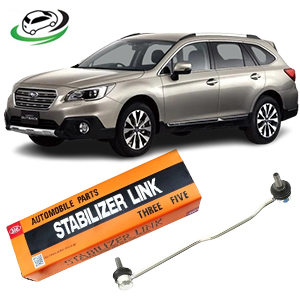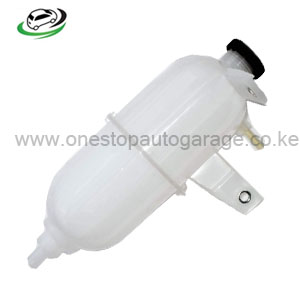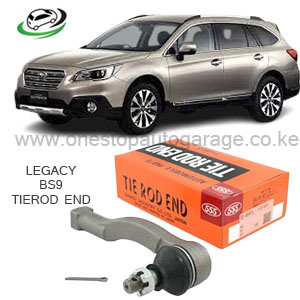-8%
Get Tie Rod End Subaru Legacy/Outback BS9
The tie rod end is a crucial component of a vehicle’s steering system, connecting the steering rack or center link to the steering knuckle. Its primary function is to facilitate steering movement by transmitting steering inputs from the steering wheel to the wheels, allowing the vehicle to change direction smoothly and accurately. Additionally, tie rod ends play a significant role in maintaining proper wheel alignment, contributing to suspension stability, and absorbing road vibrations. Let’s delve deeper into these functions and explore the signs indicating tie rod end wear:
Functions of Tie Rod End:
- Steering Control and Stability:
- Tie rod ends are integral components of the steering linkage, connecting the steering rack or center link to the steering knuckle. They transmit steering input from the steering gear to the wheels, allowing the driver to control the direction of the vehicle. Tie rod ends contribute to steering stability and responsiveness, ensuring precise handling and control.
- Wheel Alignment and Toe Adjustment:
- Tie rod ends play a crucial role in maintaining proper wheel alignment. By adjusting the length of the tie rods, tie rod ends help set the toe angle of the front wheels, which influences tire wear, steering feel, and vehicle stability. Properly aligned wheels improve tire longevity and fuel efficiency while enhancing overall driving dynamics.
- Suspension Articulation and Movement:
- Tie rod ends facilitate the articulation and movement of the front suspension system. As the wheels move up and down over bumps, dips, and uneven road surfaces, tie rod ends allow the steering linkage to flex and pivot, accommodating changes in suspension geometry and wheel travel. This promotes smooth and controlled ride quality, minimizing jolts and vibrations transmitted to the steering wheel and chassis.
- Load Distribution and Cornering Stability:
- Tie rod ends help distribute vehicle loads and forces evenly across the front wheels during cornering and maneuvering. They assist in maintaining consistent tire contact patches with the road surface, optimizing traction and grip for improved cornering stability and control. Properly functioning tie rod ends contribute to balanced handling characteristics and reduced body roll during turns.
- Impact Absorption and Shock Dissipation:
- Tie rod ends absorb and dampen impacts and shocks transmitted through the steering and suspension systems. They help cushion the effects of road irregularities, potholes, and obstacles encountered during driving, reducing harshness and vibration felt in the steering wheel and vehicle cabin. This enhances driver comfort and minimizes fatigue, especially on long journeys or rough roads.
- Steering Linkage Integrity and Safety:
- Tie rod ends contribute to the structural integrity and safety of the steering linkage assembly. They securely attach the tie rods to the steering knuckles, ensuring proper connection and alignment between the steering system components. Well-maintained tie rod ends help prevent steering play, wandering, and instability, enhancing overall driving safety and confidence.
- Component Longevity and Durability:
- Tie rod ends undergo significant stresses and forces during operation, making durability and longevity essential. High-quality tie rod ends are constructed from durable materials and feature robust designs to withstand the rigors of daily driving and harsh road conditions. Regular inspection and maintenance help identify worn or damaged tie rod ends early, preventing premature failure and ensuring reliable performance.
Signs of Wearing Out:
- Loose or Unresponsive Steering:
- Worn tie rod ends can result in loose or unresponsive steering, where the steering wheel feels excessively loose or has increased play.
- Drivers may notice that the vehicle’s steering response becomes less precise, requiring more effort to keep the vehicle on course.
- Uneven Tire Wear:
- Improperly functioning tie rod ends can lead to misalignment of the wheels, causing uneven tire wear.
- Excessive inner or outer tire wear on one or more tires may indicate a problem with the tie rod ends, necessitating inspection and replacement.
- Knocking or Clunking Noises:
- Worn tie rod ends often develop play or looseness, resulting in knocking or clunking noises when driving over bumps or rough road surfaces.
- These noises typically emanate from the front end of the vehicle and may become more pronounced during turns or maneuvers.
- Steering Wheel Vibration:
- A common sign of tie rod end wear is steering wheel vibration, especially at higher speeds.
- This vibration may be felt through the steering wheel and can indicate a loss of stability in the steering system due to worn tie rod ends.
- Visible Damage or Wear:
- During visual inspection, technicians may identify signs of wear, damage, or corrosion on the tie rod ends.
- Excessive play in the joint, torn or deteriorated rubber boots, or visible rust are all indicators that the tie rod ends may need to be replaced.
- Difficulty Maintaining Alignment:
- Worn tie rod ends can make it challenging to maintain proper wheel alignment, even after adjustment.
- If the vehicle continues to experience alignment issues despite repeated adjustments, it may be due to worn tie rod ends requiring replacement.
Follow us on Facebook



